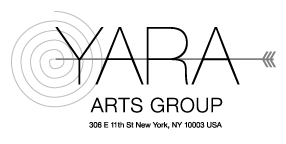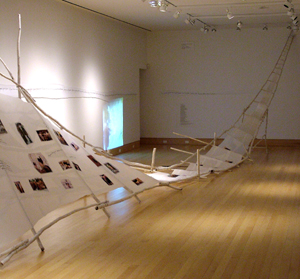
Yara's installation at Ukrainian Museum
photos by Alexnader Khantaev
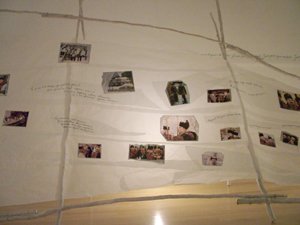
installation detail
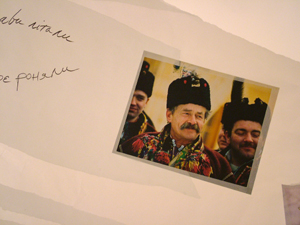
Zelenchuk of Kryvorivnia
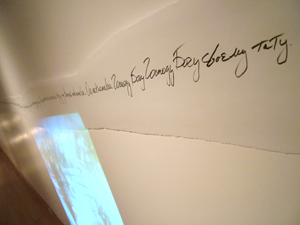
Words to an ancient winter song and video
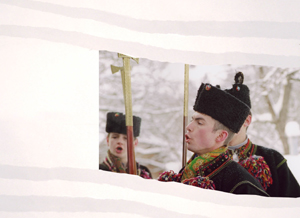
Winter song singers from Kryvorivnia
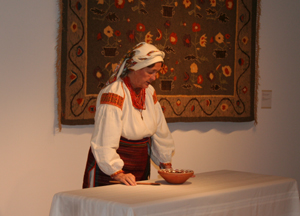
Olga Shuhan in scene from
Koliada: Twelve Dishes at opening
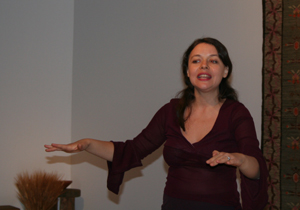
Mariana Sadovska leads the audience in a winter song at opening
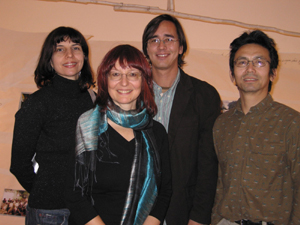
video artist Andrea Odezynska, director Viralna Tkacz, photographer Alexander Khantaev and designer Watoku Ueno
|
The Ukrainian Museum presents
Yara Arts Group's art installation
STILL THE RIVER FLOWS:
A Glimpse into the Winter Solstice
and Christmas Rituals in a Carpathian Village
conceived by Virlana Tkacz and Watoku Ueno
installation by Watoku Ueno
video by Andrea Odezynska
photography by Alexander Khantaev
translations by Virlana Tkacz & Wanda Phipps
December 11, 2005 to January 29, 2006
Wednesdays to Sundays 11:30 - 5:00 PM
The Ukrainian Museum
222 East 6th Street (between2nd & 3rd Avenues)
New York, NY 10003
(212) 228-0110
REVIEWS:
STILL THE RIVER FLOWS” GIVES ANCIENT WINTER SOLTICE RITUALS MEANING IN THE PRESENT DAY
New York, NY – At the Ukrainian Museum on Sunday, December 11, Yara Arts Group presented the art installation “Still the River Flows” along with a short performance for the opening. “Still the River Flows” provides a window into the significance that ancient Koliada Winter Solstice and Christmas rituals have in the modern day.
The title has a dual meaning. “Still” has both the sense of the frozen river and “still to this day.” The installation by Watoku Ueno showcases the beauty and mystery of the rituals, using the photographs of Alexander Khantaev and video by Andrea Odezynska.
Work on the installation began when Alexander Khantaev accompanied Yara director Virlana Tkacz to the Carpathian Village of Kryvorivnia to photograph koliada, or Ukrainian winter rituals in January 2003. They did not expect to encounter such an ancient, colorful, and extensive performance of traditions. The winter ritual that began on January 6, with the dinner of twelve dishes captivated them.
In the performance piece that preceded the opening of the installation, Olga Shuhan played a lonely housewife in an excerpt from Yara’s “Koliada: Twelve Dishes.” The excerpt not only entertained, but also served to introduce the dinner traditions. The housewife invited the spirits to dinner and recited a poetic list of traditional dishes.
The koliada rituals continue with Twelve Days of Song during which the koliadnyky, or winter song singers, go from house to house. Ms. Tkacz explained that the koliadnyky sing a separate long song to each member of the household. The songs are chosen specifically for that person by the lead singer. In a display of traditional songs that was part of the performance, Vera Slywotzky and Allison Hiroto emphasized the enchanting quality of the music with the song in which they repeated Dai Bozhe, “Oh Lord, May it by so!”
The next performance was by acclaimed Ukrainian singer Mariana Sadovksa. Sadovska involved the audience in a soulful performance of two traditional Koliada songs from Central Ukraine.
When Mr. Ueno began to design the art installation, his first step was the exploration of the Koliada rituals. He set out to discover why they were performed, but found no complete authoritative explanation. The river appeared to be central to the rituals that concluded with the blessing of the water. Ueno, therefore, made the river image central to the exhibition.
Mr. Khantaev’s photographs, which follow the chronology of the ritual, are pasted against a flowing background of white paper supported by birch branches. The image of the river is also important in Ms. Odezynska’s videos, serving as a foundation and connective tissue in the story of the koliadnyky in Kryvorivnia. The video footage of the koliadnyky performing played in opposite parts of the room creates the impression, through the use of echoes, that the viewer is experiencing the rituals firsthand.
The words to a winter song about that village of Kryvorivnia wind around the room. They anchor the installation in the place where the winter solstice and Christmas rituals remain central to the lives of the people. The Yara Arts Group effectively combined visual media and text to re-create the feeling and emotion associated with these rituals.
The exhibit “Still the River Flows” continues Wednesday to Sundays 11:30 to 5 PM through January 29, 2006, as part of the exhibition "The Tree of Life, the Sun, the Goddess: Symbolic Motifs in Ukrainian Folk Art" developed by Lubow Wolynetz, curator of the Museum's folk art collection. You may find out more about the Ukrainian Museum in New York City by visiting their web site at www.ukrainianmuseum.org.
by Olena Jennings, Ukrainian Weekly, January 1, 2006
"As I was walking through the folk costumes on the first floor, I remember how I was effected when I heard a Ukrainian winter song seep down the stairs, making me aware of the presence of another space, an upper floor. This was a space I hadn’t seen yet; here unexpectedly it was making itself present – from far away, from above. Yara Arts Group’s installation “Still the River Flows: A Glimpse into Winter Solstice and Christmas Rituals in a Carpathian Village” is made up of video paper and photographs. A river freezes as a paper sculpture in the presence of continuous video by Andrea Odezynska. The space of the second floor – is performative. When on the first floor you walk in a circle, but here you have a cube. The river breaks it with a wave, an exciting diagonal, and everything is more complex here, because you are given more freedom in terms of movement. Paper and video – are not contemporary to each other – but both are our contemporary forms of memory. Stronger than memory, at the same time they are weaker than memory. Memory – its nature and its artificiality is one of the most intriguing subjects in contemporary culture studies, history and philosophy. Who knows what is memory?… For instance, why is it that I remember those twenty minutes in the museum for over two weeks now? I known it’s because I experienced an epiphany. That sound, that song happened within me."
Svitlana Matvyienko, Simply Object and Space, Svoboda, January 13, 2006.
"On December 11 an amazing exhibit Still the River Flows: A Glimpse at the Winter Solstice and Christmas Rituals in a Carpathian Village opened in the new premises of the Ukrainian Museum in New York. The exhibit is actually an art installation which was created by theatre director Virlana Tkacz, designer Watoku Ueno, filmmaker Andrea Odezynska, photographer Alexander Khantaev and poet-translator Wanda Phipps.
The installation is a masterpiece. Using contemporary technology and media it gives us the possibility of becoming acquainted with ancient traditions and winter song rituals in a famous Carpathian village of Kryvorivnia, where Sergey Paradzanov filmed his film classic “Shadows of Forgotten Ancestors….”
Virlana Tkacz the artistic director of Yara Arts Group in New York together with her friends and colleagues traveled to Kryvorivnia several times to record folk traditions. Eventually she created the theatre piece Koliada: Twelve Disheswhich was successfully shown last year at La MaMa Experimental Theatre in New York. She invited two Hutsuls from Kryvorivnia to take part in the show and they received their American visas as unique cultural performers.
A unique aspect of the installation Still the River Flows is that is it represents a seeing of Ukrainian culture by artists from various cultures. Virlana Tkacz and Andrea Odezynska are of Ukrainian heritage born in America, Watoku Ueno is Japanese, Alexander Khantaev is Buryat, and Wanda Phipps is African-American.
Those who attended the opening of the installation Still the River Flows watched a fragment from Yara Arts Group’s show Koliada: Twelve Dishes and heard Mariana Sadovska’s unique voice."
by Kateryna Labunska, Meest Newspaper (Linden, NJ and Toronto), December 15, 2005
For press release and more photos see Still the River Flows at the Ukrainian Museum
For reviews and photos of Yara's show see
Koliada:Twelve Dishes at La MaMa
and Koliada:Twelve Dishes
|
